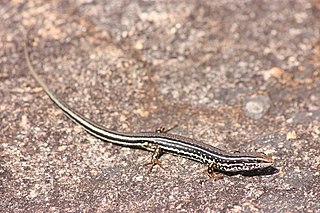
Lampropholis is a genus of skinks, commonly known as sunskinks, in the lizard subfamily Eugongylinae of the family Scincidae. The genus Lampropholis was previously found to belong to a clade with the genera Niveoscincus, Leiolopisma and others of the Eugongylus group within Lygosominae. All species of Lampropholis are endemic to Australia. For similar skinks see genera Bassiana, Pseudemoia, and Niveoscincus.

Carinascincus is a genus of skinks, commonly called snow skinks or cool-skinks and residing mainly in Tasmania or Victoria, Australia. Then recognised as the genus Niveoscincus, it was found to belong to a clade with the genera Carlia, Lampropholis and others of the Eugongylus group within Lygosominae. Cogger has rejected the use of the junior name Niveoscincus and recognizes the valid senior generic name Carinascincus for the group. For similar skinks see genera Pseudemoia, Lampropholis, and Bassiana. These skinks have adapted to the cooler weather of southern Australia and particularly Tasmania, hence the common names.
Carinascincus palfreymani, known commonly as the Pedra Branca skink, as well as the Palfreyman's window-eyed skink, the Pedra Branca cool-skink, or the red-throated skink, is a species of skink in the family Scincidae. The species is endemic to Australia, and is restricted to the windswept Pedra Branca, an island off southern Tasmania of only 2.5 ha, where it is dependent on the seabird colonies. It is the only lizard species found on the island.

Ctenotus strauchii, also known commonly as the eastern barred wedge-snout ctenotus or Strauch's ctenotus, is a small species of lizard in the family Scincidae. The species is endemic to Australia and is found throughout semi-arid and arid regions in most of Australia's mainland states except Western Australia, although one record does exist for Western Australia in 1975.

The eastern mourning skink, also known commonly as Coventry's spinytail skink and the swamp skink, is a species of lizard in the family Scincidae. The species is endemic to Australia.
The alpine cool-skink, also known commonly as the northern snow skink, is a species of lizard in the family Scincidae. The species is endemic to Tasmania in Australia.

Carlia jarnoldae, also known commonly as the lined rainbow-skink or the lined rainbow skink, is a species of lizard in the subfamily Eugongylinae of the family Scincidae. The species is endemic to the state of Queensland in Australia.
Cryptoblepharus mertensi, also known commonly as Merten's snake-eyed skink, is a species of lizard in the family Scincidae. The species is endemic to the Northern Territory in Australia.
Lampropholis caligula, also known commonly as the montane sunskink or the montane sun skink, is a species of lizard in the family Scincidae. The species is endemic to New South Wales in Australia.
Menetia alanae, also known commonly as Alana's menetia and the Top End dwarf skink, is a species of lizard in the family Scincidae. The species is endemic to Australia.

Pseudemoia baudini, also known commonly as Baudin's skink, Baudin's window-eyed skink, and the Bight Coast skink, is a species of lizard in the family Scincidae. The species is endemic to Australia.

Pseudemoia rawlinsoni, also commonly known as the glossy grass skink and Rawlinson's window-eyed skink, is a species of lizard in the family Scincidae. The species is endemic to Australia.

Saproscincus challengeri, also known commonly as the Border Ranges shadeskink, Challenger's skink, the challenging shade skink, and the orange-tailed shadeskink, is a species of lizard in the family Scincidae. The species is native to New South Wales and Queensland in Australia.

Saproscincus czechurai, also known commonly as Czechura's litter-skink, Czechura's skink, and the wedge-snouted shadeskink, is a species of lizard in the family Scincidae. The species is endemic to Queensland in Australia.
Anomalopus leuckartii, also known commonly as Leuckart's burrowing skink and the two-clawed worm-skink, is a species of lizard in the subfamily Sphenomorphinae of the family Scincidae. The species is native to eastern Australia.
Ctenotus hanloni, also known commonly as Hanlon's ctenotus and the nimble ctenotus, is a species of skink, a lizard in the family Scincidae. The species is endemic to Australia.
Ctenotus ingrami, also known commonly as Ingram's ctenotus and the unspotted yellow-sided ctenotus, is a species of skink, a lizard in the family Scincidae. The species is native to Queensland and New South Wales in Australia.

Ctenotus labillardieri, also known commonly as the common south-west ctenotus, Labillardier's ctenotus, and the red-legged ctenotus, is a species of skink, a lizard in the family Scincidae. The species is endemic to the Australian state of Western Australia.

Ctenotus leae, also known commonly as the Centralian coppertail, Lea's ctenotus, and the orange-tailed finesnout skink, is a species of lizard in the subfamily Sphenomorphinae of the family Scincidae. The species is endemic to Australia.

Eulamprus kosciuskoi, also known commonly as the alpine meadow-skink and the alpine water skink, is a species of lizard in the subfamily Sphenomorphinae of the family Scincidae. The species is native to eastern Australia.













